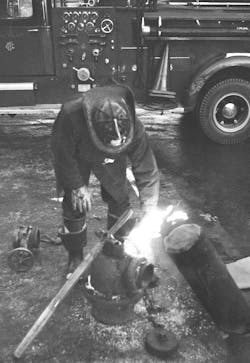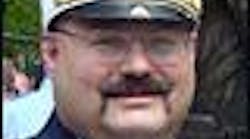We had a couple of minor calls yesterday and quite honestly, while the weather here in Southern Ohio has been in single digits for a few days, it caught some of my crew a bit short.
One call was a relatively simple two-car collision that brought down some telephone wires. The driver of the pick-up was transported and a second medic was called for to transport the driver and her kids that were in the other vehicle.
No one was seriously injured, but just needed to be checked out.
Right now, we're hitting 20-degree temps with a 5-degree wind chill. No big problem for those of us who are used to up-north temperatures, but those temps yesterday hit me a bit harder than normal, probably because I was caught unprepared.
The chief had command and our engine simply had to secure the scene, disconnect the batteries and help with the injured. My job as the second chief was to to just be around, so I grabbed my camera. I had my bunkers on because I brought them inside the house last night, and suited up with the rest of the gear from my car. Not an hour earlier, my wife gave me a pair of Thinsulate gloves and a wool hood that, while it would not be the best choice for firefighting, would have been perfect for the job at hand. Of course, I left them both in the house.
Working the camera with a bare right hand almost immediately triggered the pain caused by an untold number of frostbites from years ago, beginning in Chicago when we fought fires in those days wearing wet and frozen Salvation Army cotton work gloves. Of course, firefighter's salvation (pardon the pun) in those frigid hours was when we could take a break and go the canteen, getting a hot cup of coffee and a dry pair of gloves.
Nothing could ever compare to experience of shoving your wet, frozen hands into a new pair of those cheap Salvation Army work gloves with their fuzzy interior lining. It was like heaven. New dry gloves wrapped around a cup of red-hot coffee made things a little more bearable on those long nights.
Of course, the absolutely best experience was to get back to quarters, find out that you had a change company there filling in to help you bed dry hose, and then go to the kitchen where the cook had simmered a big pot of chicken soup all day. Coffee in the middle of the night helped warm you a bit, but nothing could compare to a cup of hot chicken soup burrowing into your very frozen soul to get you going once again.
In the old days, every Chicago engine kept a large coffee can filled with kerosene, soaking a bunch of rags wrapped around a coat hanger. When a frozen hydrant was found, it was a simple matter to ignite the rags, and stick them in the steamer opening of the hydrant. Most likely, water was frozen around the operating nut and a few minutes of your man-made firestorm was enough to melt it and allow the nut to turn. If not, you just poured the rest of the kerosene into the hydrant and dropped the flaming rags into the barrel, which usually was enough to melt any water at the bottom and allow the hydrant to be opened. Of course today, we would have to get permission from the EPA to conduct such an operation
In any event, take some advice. Get your finger out of your ear and make sure that you have warm gear when you respond from home, extra gloves and a hood tucked away in the rig for when you get wet and when extended operations are keeping you from rehabbing.
Also keep in mind that you will need something more than watery coffee to take the chill out of your cold bones. Microwaves can be as important as dry hose when you are wet and cold. When you get back to quarters, your spare set of dry, warm gear will get you back into service quickly. Make sure you change over as soon as you can, certainly before you start to dry your used hose.
Nothing is better and safer than a warm firefighter when temperatures are below freezing. Make sure you think ahead and operate accordingly.








